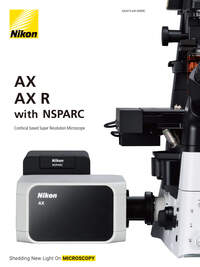- fr Change Region
- Global Site
- Accueil
- Produits
- Microscopes confocaux et multiphotoniques
- AX / AX R with NSPARC
Glial cell surrounded by axons in a rat neuronal culture labeled for microtubules and actin
Dr. Christophe Leterrier, NeuroCyto, INP, Marseille, France
Regard intérieur
Regard intérieur Images beyond your imagination. Maximizing AX/AX R performance: The confocal-based super-resolution microscope AX/AX R with NSPARC.
Through simple external mounting on the AX/AX R confocal microscope system, NSPARC enables super-high-speed scanning with unprecedented high resolution for observation and acquisition of images, showing even the slightest of changes in living cells that cannot be detected with conventional confocal laser microscopes. Its developers spoke of their ambitious challenge of aiming higher.

What was the development concept for NSPARC?
Healthcare Business Unit
Technology Solutions Sector
System Development Department
Development Project Promotion Section
Wataru Tomosugi
Tomosugi: “Providing images that are not just beautiful, but also enable us to obtain new knowledge for molecular biology and cell biology” — which is our vision. We prioritized expandability for the AX, which was the original development concept. Focusing on this expandability, we aimed to further enhance the resolution of the AX. Our aspiration was to eliminate restrictions on the sample that is to be observed and provide an environment that realizes observation of all samples with high resolution. This inspired the development of NSPARC.
Healthcare Business Unit
Technology Solutions Sector
System Development Department
First Development Section
Junya Ohkawa
Ohkawa: Confocal laser microscopes play a central role among the instruments used during experimentation in laboratories. Therefore, we wanted to provide easy-to-use operability, GUI, and workflow as much as possible for all users ranging from beginners to professionals, so that the system could be utilized readily on research frontlines.
What technology serves as the core?
Tomosugi: NSPARC utilizes technology obtained through joint research at the Nikon Imaging Centre (NIC@IIT) and the Molecular Microscopy and Spectroscopy (MMS) Lab at the Istituto Italiano di Tecnologia (IIT). The unique point is that a special detector known as the SPPC (single-pixel photon counter) array detector, which serves as the central section, is equipped.
What were the most challenging issues during development?
Tomosugi: As development progressed, we gradually realized that we could actually capture high-resolution images that had never been seen before. However, in order to always attain the very best performance, it is necessary to place the center of the detection light in the middle of the SPPC array detector –but what kind of algorithm should be used to correct the optical axis? Mobilizing all of the knowledge obtained through repeated evaluations, every member of the team worked on this issue, aiming for more delicate and highly robust correction.
Ohkawa: This product required alignment with higher precision than conventional microscopes, so this was quite a challenging situation. Not only that, the parameters of confocal laser microscopes range widely. Therefore, it took considerable effort to effectively organize each of the specifications.
Tomosugi: Ultimately, I think the ideal is to minimize the number of parameters that the customer handles. We can indeed attain the best performance for brightness and resolution by adjusting the optical axis so that the detector light hits the center of the detector, which is an ultra-small detector less than 1mm in size. This is why we spent lots of time considering the adjustment methods when assembling at the factory and setting up, the tools, and the software.
By checking the status of the detector light numerous times under various conditions using internal software, I think we were able to come up with the most appropriate solutions for hardware and software. We mounted an auto-alignment function so that the optical axis shift at the tens of μm level which depends on the environment and shooting conditions, can be easily adjusted.
I believe that these are important technical points that enable users to always benefit from the best performance when employing this product, and provide peace of mind.
Ohkawa: There is also the issue of balance — how to reduce parameters for simple operation while eliciting maximum performance. For both the user interface and software specifications, we started by visiting several research institutions and observing actual experiments to collect essential information about what is required.
Tomosugi: We could not just accept a trade-off between usability and best performance. We faced difficulties and used the utmost creativity in carefully considering the optimum balance. You could say that we successfully completed the NSPARC system by mobilizing the wisdom and technologies of all fields, including optical, mechanical, electrical, and software.
A super-resolution microscope may sound slightly daunting to users, but it’s also important that its complexity is transparent to the operator.
Ohkawa: That’s very true, because our aim was to achieve usability that wasn’t much different from conventional confocal laser microscopes. The aspiration of the developers was to enable this instrument to be used as easily as possible, somewhat like a "super-resolution microscope for everyday use".
This raises anticipations for the world that NSPARC will open up.
Tomosugi: We hope to contribute to society by having NSPARC used to obtain knowledge about new life phenomena. I’d like as many people as possible to observe a familiar sample with NSPARC once. They might discover new life phenomena or other natural phenomena that they had not noticed before.
Ohkawa: I hope that by using NSPARC to observe previously viewed samples, users will make new biological discoveries. By raising the spatial resolution, I believe that there will be many cases of new phenomena being detected, even with familiar samples. I would be thrilled if these biological discoveries lead to developing new drugs or clarifying the mechanism of diseases.


